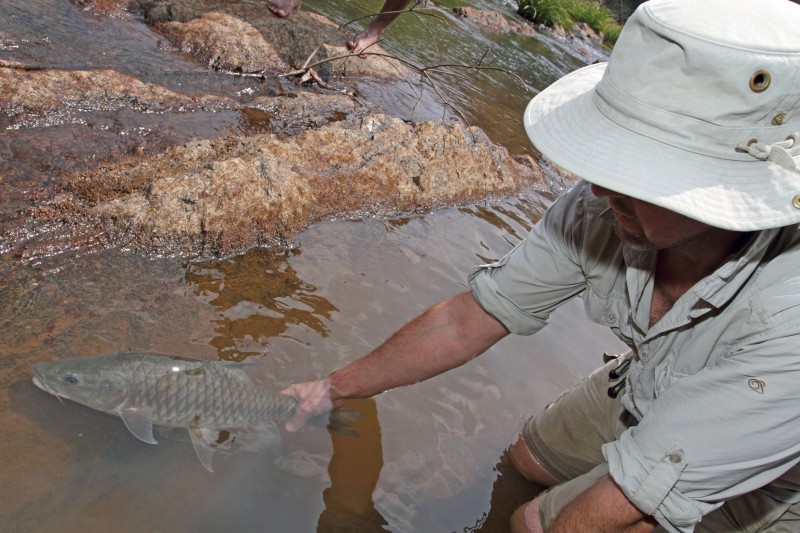Preventing an iconic Indian fish from going the way of the Dodo.
The Research
From the time of the Raj the massive humpbacked mahseer was renowned in angling circles as one of the largest and hardest-fighting freshwater fish in the world. It drew anglers from all over the globe to its native River Cauvery in India to find it. Now the legendary fish, one of the world’s most iconic freshwater fish, is on the brink of extinction according to scientists from Bournemouth University and Kerala University of Fisheries and Ocean Studies in Kochi, India.
After realising that the fish caught in the River Cauvery did not match the historical depictions of the humpbacked mahseer, BU’s Professor Robert Britton and Adrian Pinder decided to investigate. They began by studying the ecology, taxonomy and conservation status of 17 species of mahseer throughout South and Southeast Asia. Using catch data from recreational fisheries, along with field studies, they demonstrated that the humpbacked or orange-finned mahseer was not only nearing extinction but was actually being replaced by its artificially-bred, non-indigenous blue-finned cousin.
With the Mahseer Trust, they have been raising awareness and campaigning to add the humpbacked mahseer to the IUCN Red List, which lists endangered species across the world including giant pandas. To add the fish to the list it needs a scientific species name which, despite its fame, the humpback mahseer doesn’t have. The team have been using DNA and field studies to find the evidence required to enable the fish to be listed as a species before it can be classified as ‘critically endangered’.
Having the humpbacked mahseer listed as ‘critically endangered’ would help the Mahseer Trust to campaign for and implement breeding programmes and hopefully save the legendary fish from extinction.
The Academic
Professor Rob Britton
For research to impact conservation, it must be robust, be disseminated and then be used as the basis for revising current policies and practises. Our work on the mahseer is now providing that robust research that has been disseminated globally via strong media coverage resulting in, for example, increased in-country knowledge on this imperilled fish. It is now impacting local practices through reviewing the release of the artificially bred fish.
That our work is also resulting in the species being Red-listed is especially satisfying, as this provides the international recognition of their degraded status and the impetus for driving conservation plans forward. Our work also has benefits closer to home by providing an excellent case study for our students on how research can be applied to conservation and makes a real impact on conservation practices. Whether in Dorset or Southeast Asia, we can demonstrate research at BU is making a real difference to the future of biodiversity.
The Student
Adrian Pinder
Seeing any animal go extinct is a depressing prospect, particularly if this could be avoided through corrective intervention. Using recreational angling records collected over the last 50 years, our research has demonstrated that the future of the legendary humpbacked mahseer is bleak, yet not without hope. Despite the considerable bureaucratic and political challenges involved in conducting scientific research in India, through effective collaboration with the Mahseer Trust, local stakeholders and international media, we have been successful in highlighting the national biodiversity threat of stocking Indian rivers with non-indigenous mahseers; a practice widely implemented in the name of conservation across India.
Having delivered a series of in-country conservation workshops, our research is now impacting on fisheries policy and affecting changes in stocking practices. While this is an important first step in conserving India’s aquatic biodiversity, the discovery of a genetically pure population of humpbacked mahseer in one of the tributaries of the River Cauvery provides hope that our respective short and long-term goals of naming the fish and artificial propagation to save the species from extinction is achievable.
The Impact
Dr AJT Johnsingh, Indian wildlife conservationist, ecologist and former member of the Wildlife Institute of India
Until recently, neither scientists or the angling community were aware of the endemic and critical conservation status of the legendary humpbacked mahseer. However, the work Bournemouth University’s Adrian Pinder and Rob Britton have done in association with the Mahseer Trust has demonstrated the negative effects of mahseer stock augmentation programmes and the current vulnerability of this iconic species to extinction. Their findings represent a significant contribution to understanding the taxonomy and the temporal and spatial population status of humpbacked mahseer, which is of national importance to broader wildlife conservation in India.
Their study has also resulted in state fisheries departments re-examining current policy relating to fish stocking for conservation and through high-profile media coverage has effectively raised awareness of mahseer conservation and aquatic ecology throughout India.
This research will help to inform future surveys of tributaries and the initiation of a breeding programme if pure strains of the humpbacked mahseer can be found in time. Following that the implementation of suitable conservation programmes may enable the humpbacked mahseer to stage a comeback in the Cauvery River, and return the species from the brink of extinction.



